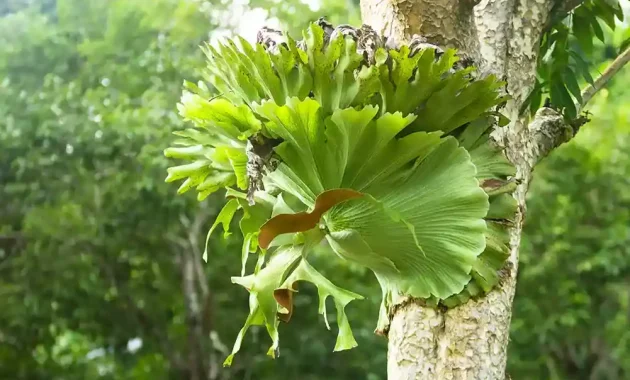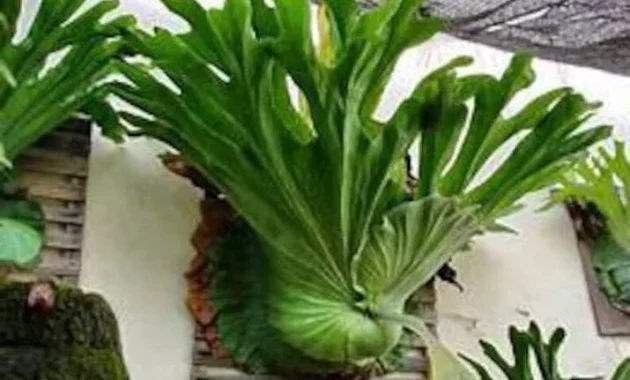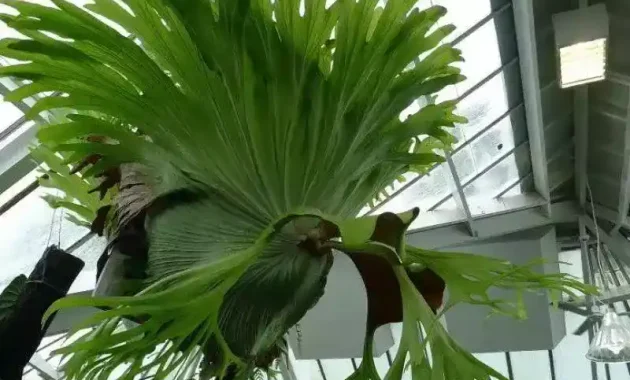Welcome to the world of Platycerium grande, the giant staghorn fern! Have you ever wondered about this magnificent plant and how to care for it? Look no further! In this article, we will explore the anatomy, ideal growing conditions, propagation techniques, proper care and maintenance, creative display ideas, as well as common pests and diseases of the Platycerium grande.
Platycerium Grande, also known as giant staghorn fern, is a species of epiphytic fern in the family Polypodiaceae. It is native to the tropical rainforests of Southeast Asia, including Indonesia, Malaysia, and the Philippines. This fascinating fern has captured the attention of botanists and horticulturists alike with its unique physical characteristics. With its large fronds resembling antlers and its stunning green hues, the Platycerium grande is sure to make a statement in any garden or indoor space.
But don’t just take our word for it. We will provide you with objective and factual information based on scientific evidence and research. Get ready to dive into the world of this extraordinary plant and learn everything you need to know about cultivating your very own Platycerium grande!
Anatomy of the Giant Staghorn Fern
Get ready to dive into the fascinating world of the giant staghorn fern and explore its intricate anatomy! The Platycerium grande, commonly known as the staghorn fern, is a unique and visually striking plant that belongs to the Polypodiaceae family. This fern is named after its distinctive antler-like fronds that resemble the horns of a stag.
The anatomy of this fern is quite intriguing. It consists of two types of fronds: fertile fronds and sterile fronds. The fertile fronds are responsible for reproduction and can be easily identified by their spore patches located on the lower surface. These patches contain tiny structures called sporangia, which release spores for reproduction.
On the other hand, the sterile fronds serve a protective function for the plant. They grow in a circular shape around the fertile fronds and look like shields or plates, hence their name ‘shield fronds.’ These shield-shaped fronds provide support and protection to both younger growing parts as well as older reproductive parts.
The platycerium grande boasts large leafy green foliage with an elongated shape. Its leaves have a leathery texture and can reach impressive sizes up to 4 feet long! Additionally, they exhibit an attractive shade of green that adds vibrancy to any garden or indoor space.
Understanding these plant characteristics is essential for successfully cultivating and caring for staghorn ferns. By providing them with appropriate environmental conditions such as indirect sunlight, high humidity levels, and well-draining soil, you can ensure their optimal growth and overall health.
So why not embark on this botanical adventure and become acquainted with this magnificent species?

Ideal Growing Conditions for the Platycerium grande
Create an idyllic environment for your impressive Platycerium grande by ensuring it is placed in the perfect growing conditions. This magnificent staghorn fern thrives under specific environmental requirements that mimic its natural habitat.
First and foremost, light levels play a crucial role in the growth of this plant. Provide bright, indirect light to stimulate healthy leaf development and avoid direct sunlight, which can scorch its delicate fronds.
In addition to proper lighting, good air circulation is essential for the Platycerium grande’s well-being. Ensure that there is adequate ventilation around the plant to prevent stagnant air and promote transpiration. This can be achieved by placing it in a well-ventilated area or using fans to create gentle airflow.
Humidity is another critical factor for successful cultivation of this fern species. Maintain a humid environment by misting the foliage regularly or grouping it with other indoor plants to increase ambient moisture levels.
When it comes to potting mixture, use a well-draining medium that retains moisture without becoming waterlogged. A suitable mix may include orchid bark, sphagnum moss, and perlite or vermiculite.
To conclude, providing ideal growing conditions for your Platycerium grande involves optimizing light levels, ensuring good air circulation and humidity, as well as selecting an appropriate potting mixture. By adhering to these guidelines, you will create an optimal environment for your spectacular staghorn fern’s growth and overall health.
Propagation Techniques for the Staghorn Fern
Discover how you can easily multiply the beauty of your majestic plant by learning simple propagation techniques. Propagation is the process of creating new plants from existing ones, and for the Platycerium grande, it can be done through spore propagation or vegetative propagation.
Spore propagation involves collecting spores from the fertile fronds of the giant staghorn fern. These tiny reproductive units are released into the air and can be collected using a clean container placed underneath a mature spore patch. Once collected, the spores can be spread onto a suitable potting soil mix and kept in a warm and humid environment to encourage germination.
Vegetative propagation, on the other hand, involves dividing or detaching sections of the parent plant to create new individuals. This technique is commonly used for hybrids Platycerium species with unique characteristics that are desired to be preserved. Sections with roots or growth points can be carefully separated and potted up in well-draining potting soil.
Regardless of the chosen method, it is important to provide optimal growing conditions such as bright but indirect light, high humidity levels, good air circulation, and regular watering to ensure successful establishment of propagated plants. With proper care and attention, you can enjoy an expanding collection of these magnificent plants in your home or garden.
Proper Care and Maintenance of the Giant Staghorn Fern
To ensure the health and longevity of the giant staghorn fern (Platycerium grande), proper care and maintenance are essential. This magnificent plant, known for its unique binomial nomenclature, requires specific environmental conditions to thrive as a houseplant.
- Soil: The giant staghorn fern prefers well-draining soil that is rich in organic matter. It should be slightly acidic with a pH range between 5.5 and 6.5.
- Roots: These plants possess an extensive root system that serves multiple functions, including anchoring the fern to its substrate and absorbing water and nutrients from the environment. Care must be taken not to damage or disturb these delicate roots during routine maintenance.
- Staghorn Ferns: As part of their botanical classification, staghorn ferns are epiphytic plants that naturally grow on trees or rocks instead of in soil. Therefore, mimicking this habitat by mounting them on a wooden board or bark slab can enhance their growth and overall health.
The physical characteristics of Platycerium grande include large fronds resembling deer antlers, which give rise to its common name ‘staghorn.’ The fronds exhibit a striking green coloration with textured surfaces, adding visual interest to any space they inhabit.
Remember, providing accurate information is crucial when caring for the giant staghorn fern. By following proper care techniques and understanding its unique requirements related to soil composition, root health, and natural growth habits, you can enjoy this stunning plant for years to come.

Creative Ways to Display the Platycerium grande
Enhance your space with unique and artistic ways to showcase the magnificent beauty of Platycerium grande, commonly known as the giant staghorn fern. This article section will provide you with creative ways to display this captivating plant in a contextually relevant manner.
The Platycerium grande is a fascinating plant that belongs to the Polypodiaceae family and falls under the binomial nomenclature of Platycerium bifurcatum. It has distinct fronds with two different leaf types: fertile and sterile. The fertile fronds are elongated and pendulous, while the sterile fronds are broad and shield-shaped, resembling antlers. These distinct leaf shapes make it an extraordinary addition to any space.
To display this unique plant creatively, consider:
- Mounting it on a wooden board or hanging it from a wall using ropes or macrame hangers.
- Placing it in a decorative pot or hanging it upside down from the ceiling for an eye-catching look.
- Creating a vertical garden by attaching multiple plants to a living wall structure.
Remember that Platycerium grande requires indirect light, high humidity levels, and regular watering without soaking its roots. By providing these environmental requirements along with your creative display ideas, you can showcase this giant staghorn fern in all its glory.
Common Pests and Diseases of the Staghorn Fern
Moving on from creative ways to display the majestic Platycerium grande, let’s now delve into a crucial aspect of its care: common pests and diseases that can plague this magnificent fern. As a botanist or horticulturist, you need to be well-versed in identifying and combatting these threats to ensure the health and vitality of your staghorn fern.
The table below provides an overview of some prevalent pests and diseases that may afflict the Platycerium grande:
| Pest/Disease | Symptoms | Treatment/Prevention |
|---|---|---|
| Leaf Spot | Circular brown spots on leaves; yellowing foliage | Remove affected leaves; improve air circulation |
| Compost Infestation | Foul odor, mold growth in compost | Replace with fresh compost; maintain proper moisture levels |
| Bacillus thuringiensis (Bt) | Caterpillar infestation; holes in fronds | Apply Bt spray according to package instructions |
It is vital to actively monitor your staghorn fern for any signs of these pests or diseases. Prompt action is necessary in order to prevent their spread and mitigate potential damage. Remember, as a botanist or horticulturist, it is imperative to rely on scientific evidence and research when addressing these issues rather than personal opinions.
By familiarizing yourself with these common pests and diseases, you will be better equipped to provide accurate care for your beloved Platycerium grande.
Frequently Asked Questions
How long does it take for a Platycerium grande to reach its full size?
A platycerium grande takes several years to reach its full size, typically around 5-10 years. It is characterized by its large fronds, which can grow up to several feet long and have a unique antler-like shape.
Can the Giant Staghorn Fern be grown indoors?
Yes, the giant staghorn fern (Platycerium grande) can be grown indoors. It requires bright, indirect light and high humidity levels. Use a well-draining potting mix and water regularly to keep the soil moist but not soggy.
Is it possible to divide a mature Staghorn Fern to create new plants?
Yes, it is possible to divide a mature staghorn fern to create new plants. This can be done by carefully separating the plant’s rhizome into sections, ensuring each section has enough roots and fronds for successful growth.
What is the recommended watering schedule for the Platycerium grande?
The recommended watering schedule for Platycerium grande is to water it thoroughly once a week, allowing the soil to dry out slightly between waterings. Avoid overwatering, as it can lead to root rot.
Are there any particular fertilizers that work best for the Giant Staghorn Fern?
For the giant staghorn fern, it is recommended to use a balanced fertilizer with equal amounts of nitrogen, phosphorus, and potassium. This will promote healthy growth and ensure proper nutrient uptake.


